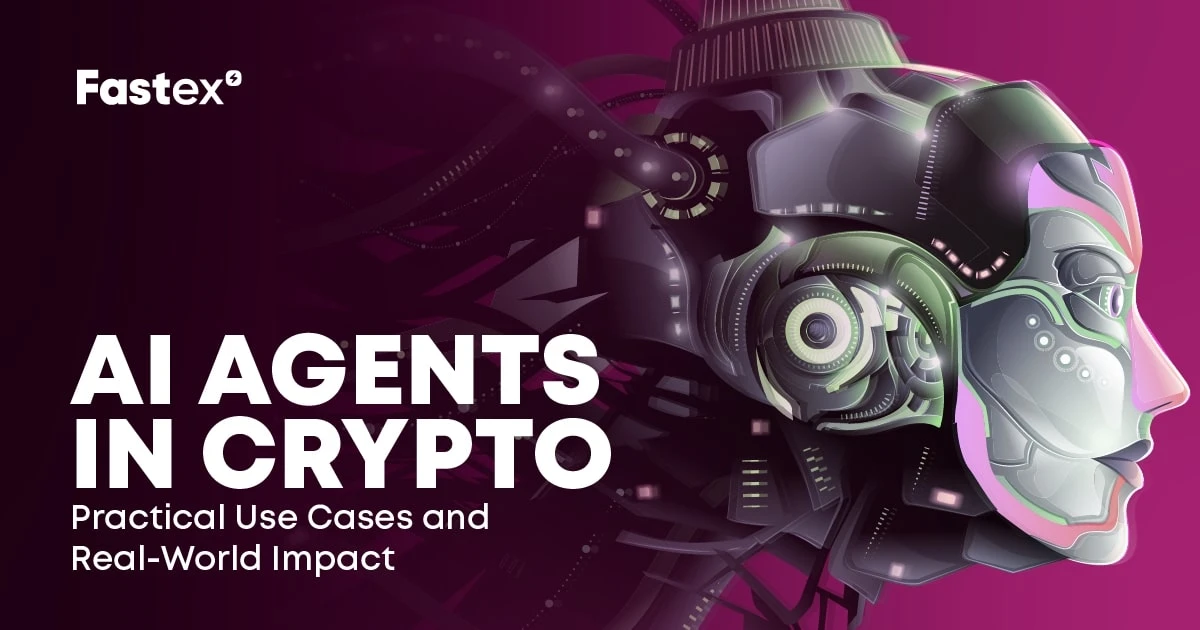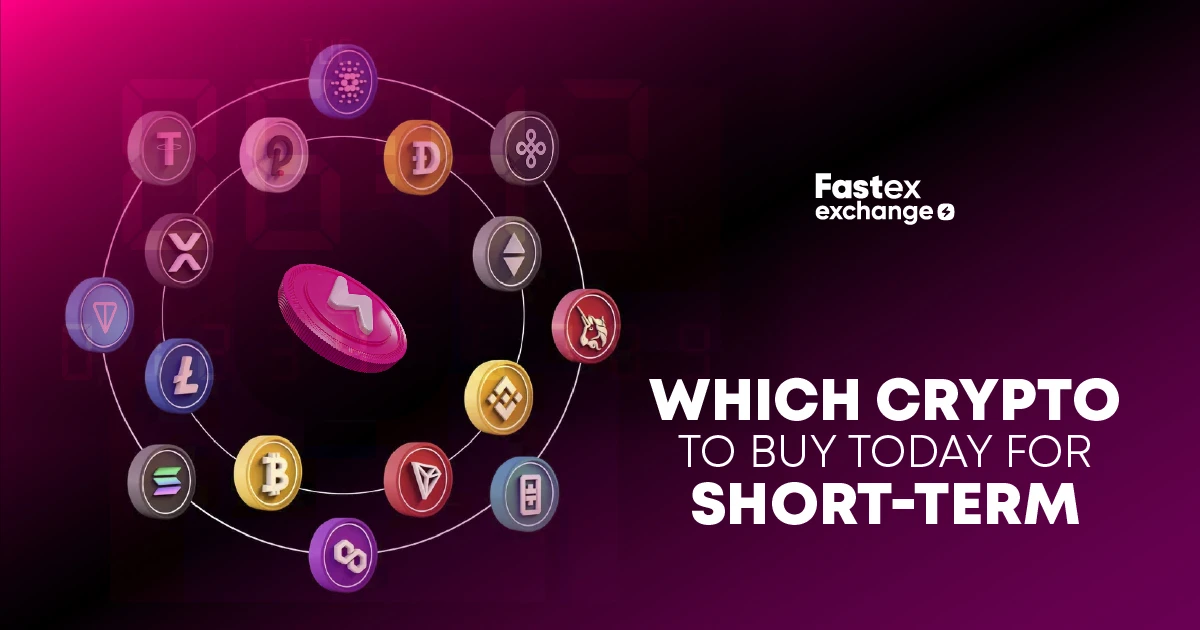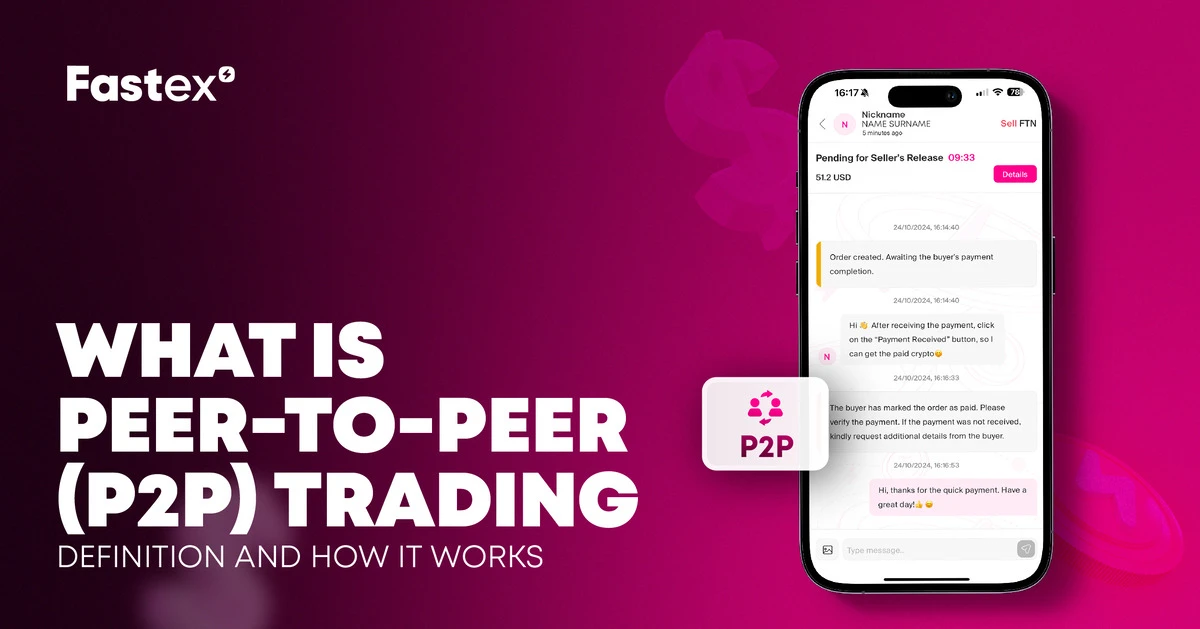On This Page

AI Agents in Crypto: Practical Use Cases and Real-World Impact
You've probably noticed how we’re outsourcing chunks of our daily decision-making to AI. At some point, you might’ve asked yourself: can I just let AI handle my entire job?
Now, let’s take it a step further. Say your job—or passion—is trading, specifically in crypto. Could an AI take over entirely? Could it make perfect, emotionless decisions, never hesitate, and always know the best move? Sounds like a dream for anyone wondering whether to buy, sell, or just give up.
But how exactly do AI agents work, and why are they becoming so essential? In this article, we’ll look at how AI agents reduce risks, enhance efficiency, and make crypto easier to navigate.
What is an AI agent?
An AI agent is a software program that’s designed to act autonomously, using artificial intelligence to perform tasks with minimal human involvement.
Surely, AI can do the math, but can it read the room? Can it predict how fear or excitement might change the market when a big player suddenly makes a move? Let’s take a closer look at how you can utilize them.
Use Cases of AI Agents in Cryptocurrency
In crypto, AI agents can analyze massive amounts of market data in real-time, make trades faster than you could, and even minimize risks by sticking to pre-set rules. Here are three main areas where AI is applicable:
1. Automated Trading According to the following article, crypto AI agents can monitor market conditions in real time and execute trades based on predefined strategies.
2. Portfolio Management Managing a diversified crypto portfolio is no small task, but the CFA Institute’s review of AI in asset management highlights that they can analyze market trends and ensure portfolios stay aligned with investment goals and risk tolerance, saving your time and effort.
3. DeFi Interactions And what about DeFi? The following research on AI-enhanced DeFi interactions explains how crypto AI agents can automate tasks like yield farming, staking, and liquidity provision.
Trading and managing assets used to be about patience and willingness to take risks. Would that still be the case if you introduce AI to your daily operations? Let’s see what things will change if you’d use them in Decentralized Finance.
AI Agents in Decentralized Finance (DeFi)
DeFi, with its promise of permissionless access to financial tools, has always been powerful—though, let’s be honest, not exactly user-friendly. Let’s look at the different ways crypto AI agents can be helpful:
AI Agents in Lending and Borrowing Protocols
Take risk assessment, for example. Using machine learning, AI agents analyze borrower data with precision, delivering risk evaluations that leave old-school credit scoring in the dust. This approach is supported by the following research on AI-driven lending protocols, which is a win for lenders and borrowers alike.
AI agents also can monitor market liquidity in real-time, adjusting interest rates dynamically. Borrowers get fairer terms, and lenders maximize their returns.
Now let’s talk about collateral management and the safety net of lending. We’ve all seen the panic that comes with potential liquidation. AI agents are stepping in to track these situations proactively. They predict risks, adjust positions, and act before a crisis hits.
If those concepts seemed simple enough, how about we take a closer look at what AI agents can do in DeFi.
Loan Origination Automation in DeFi Protocols
When Decentralized Finance was first introduced, it felt like it’s promising something better than what we have. But it was complex, so we couldn’t appreciate it fully. Now when AI is added to DeFi, we, as users, start to feel that those better things are suddenly delivered. We live in a time, when AI agents can:
- Automatically aggregate credit reports and transaction histories, reducing manual input.
- Analyze traditional and alternative data for accurate risk evaluation.
- Cross-check documents with trusted databases to ensure compliance and prevent fraud.
It’s hard to argue against the benefits. Faster approvals, fewer mistakes, and less frustration for everyone involved. Loans can be approved and disbursed in minutes. And it gets even more exciting.
Collateral Management in DeFi
AI also automates collateral management in DeFi - it handles real-time monitoring to track collateral values, automates margin calls to alert borrowers when action is needed, and executes liquidations to protect lenders in case of default. Manual oversight is practically eliminated if you use an AI agent in that sense. But will you? If so, don’t get too excited until you hear about Automated Market Making.
AI Agents in Automated Market Making (AMMs)
Automated Market Makers (AMMs) are replacing traditional order books. Newly introduced AI agents are optimizing how AMMs function, making them more efficient, and better suited to the dynamics of digital asset trading. Their introduction has all the aforementioned benefits of automation - basically automating what's already kind of autonomous; so let’s move into what it changes exactly.
Smarter Liquidity Pool Management
First, let’s discuss liquidity pools that allow traders to swap assets without a centralized intermediary. Keeping these pools efficient requires constant monitoring and adjustment—something AI agents already can do. They dynamically rebalance token ratios, ensuring trades remain smooth and slippage stays low, even as markets shift.
Beyond balancing, AI reduces risks for liquidity providers by analyzing real-time data to minimize impermanent loss, which can often erode profits during volatility. AI agents also design smarter reward structures to keep pools attractive and competitive.
On the pricing front, AI refines traditional models with new strategies that respond to market trends in real time. It predicts shifts, adjusts proactively, and continuously learns from trading activity to improve speed and accuracy.
If that feels like AI already can take the most overwhelming parts of crypto trading on itself, brace yourselves - we’re going to discuss the trading bots and how AI has just improved them.
Cryptocurrency Trading Bots
AI-powered trading bots work on a completely different level than basic ones. They improve their strategies over time and learn from every trade.
AI Agents in Automated Trading Algorithms
AI-powered trading bots work on a completely different level than basic ones. They improve their strategies over time and learn from every trade. Unlike traditional bots that follow fixed rules, AI bots respond to real-time data.
Market Trend Analysis
They analyze market trends, track price changes, and even pick up on surprising events, making them smarter and more flexible.
Thus, they make decisions by spotting patterns in data before they’re obvious. It’s something not many humans can do.
Arbitrage Strategies
They’re also great at catching quick opportunities, like price differences between exchanges, and acting on them faster than any human could.
Why It Matters
What makes AI bots special is their ability to trade with accuracy, unaffected by emotions that can lead to poor decisions. Now, be cautious for them not to replace your human judgement, but to help it be more effective.
Algorithmic Order Execution
AI agents and trading bots don’t just stop at deciding what to trade—they’re also redefining how trades happen. That’s where algorithmic order execution automates the process to optimize timing, pricing, and efficiency.
High-Frequency Trading (HFT): Rapid, Strategic, and Controversial
High-frequency trading (HFT) operates at speeds that are almost beyond comprehension. Using advanced algorithms, it can execute thousands of trades in mere fractions of a second, making small profits from short-term price changes. At its core, HFT relies on three main strategies. One is market making, which involves placing frequent buy and sell orders to earn from the bid-ask spread while also adding liquidity to the market. Another is arbitrage, where traders identify price differences for the same asset on different exchanges and profit from those gaps. Lastly, there’s latency arbitrage, which takes advantage of slight delays in price updates across exchanges, allowing traders to act before the market adjusts.
Unfortunately, HFT bears huge risks. The incredible speed of these trades can sometimes trigger sharp price swings, and errors in the underlying algorithms have the potential to create disruptions, such as “flash crashes”.
Liquidity Optimization: Big Trades, Better Strategies
If HFT is about speed, liquidity optimization is about finesse. Large trades have the power to influence markets, and if not handled carefully, they can lead to the actual prices differ from what was expected. Liquidity optimization helps prevent this by pacing trades strategically to minimize price changes, balancing the need for quick execution with the potential impact on the market. It also involves smart order routing (SOR), where algorithms search across multiple exchanges to find the best prices and liquidity.
These strategies highlight two approaches to navigating crypto markets: speed versus precision. The right approach is to be determined by users personally, because the goals you set are only yours.
AI Agents in Off-Chain Data Integration
As algorithmic strategies streamline how trades are executed on-chain, the question arises: how does blockchain interact with the outside world?
Real-World Event Monitoring
AI agents can excel at continuously monitoring external data sources like news outlets, social media, and IoT devices. By analyzing this data, they detect trends or events that could impact blockchain applications.
For instance, in supply chain management, an AI agent might track environmental conditions during transit to ensure product quality. Once this data is verified and stored immutably on the blockchain, it becomes a trusted record for all parties involved. As a result, we get smarter, more reliable systems that adapt in real time.
Sensor Data Ingestion
IoT sensors generate vast amounts of data, but raw information is only valuable if it can be acted upon. AI agents process sensor data, making it actionable within blockchain applications.
Take infrastructure monitoring as an example: AI agents analyze IoT sensor data from bridges to predict when maintenance is needed. The data is securely stored on the blockchain, while smart contracts enforce timely repairs, reducing inefficiencies.
Governance and DAO Agents
As AI agents push blockchain systems to connect with off-chain data, their role in governance becomes even more crucial. AI agents are capable of streamlining DAO governance, again, automating processes. Here are some of them:
Sentiment Analysis: Understanding Community Dynamics
In a DAO, everyone’s input matters, but it’s not always easy to understand what the whole community thinks. AI tools make this clearer by analyzing conversations, proposals, and feedback. They can show how members feel about certain ideas, helping decisions match what the community wants. AI can also spot common concerns or popular suggestions, helping the organization focus on what matters most. By providing clear insights, AI makes decision-making easier and builds trust in leadership.
With AI, DAOs can better understand their communities, making members feel valued and heard.
Impact Simulation
Decision-making in a DAO is about understanding what their choices might lead to. Now, AI tools can help by analyzing past data and modeling possible future scenarios. They can forecast results, showing the potential risks and benefits of proposals before they’re put into action. AI can also help refine plans to improve outcomes and avoid unintended problems. Additionally, it offers insights for smarter resource allocation, ensuring funds and assets are used effectively.
Autonomous Policy Enforcement
Rules in DAOs are designed to be fair and transparent, but relying on manual enforcement can compromise those values. AI tools ensure that policies are applied consistently by automatically executing smart contracts, which enforce rules directly through blockchain code. They also monitor compliance, catching any deviations and addressing them immediately. Additionally, AI can issue penalties or rewards promptly and without bias, ensuring fairness.
The result is a system where governance is not only efficient but also trusted by all participants. It can not only enforce rules, but safeguard the system. This is the foundation on which fraud detection and crypto security builds upon.
Fraud Detection and Security in Cryptocurrency
As AI agents advance governance and streamline DAO operations, they now also can help with fraud detection, smart contract auditing, and system defense, addressing vulnerabilities before they escalate into threats. Here is how it can protect your digital assets:
1. Spotting Suspicious Activity
Fraud often hides in the details, but AI excels at spotting theml:
- Unusual Patterns: It detects things like sudden transaction spikes or odd behavior that might signal fraud.
- Red Flags: AI looks for phishing tactics, identity theft signs, or double-spending attempts.
- Instant Alerts: Real-time warnings ensure quick responses to suspicious activity.
By learning from past incidents, AI keeps improving to outsmart fraudsters.
2. Securing Smart Contracts
Smart contracts power crypto transactions, but bad code can break them. Here’s how AI helps:
- Finds Flaws Automatically: From reentrancy bugs to logic errors, AI scans for issues in the code.
- Improves Reliability: It catches mistakes early, protecting trust and preventing loss.
- Speeds Up Deployment: Developers save time while ensuring security is solid.
AI auditing ensures that smart contracts are dependable and ready for the real world.
3. Testing Defenses with Simulations
To stay ahead of hackers, you need to think like one. AI runs simulations to uncover weaknesses:
- Realistic Scenarios: Mimics actual attacks to test a system’s strength.
- Fixes Before It’s Too Late: Pinpoints vulnerabilities and helps resolve them proactively.
- Evolves with Threats: Uses insights to build stronger defenses over time.
These simulations prepare systems to handle threats before they strike.
Now, if you’re ready, let’s cover even more ways AI can help your crypto activities. And this time, let’s talk about “tokenomics”.
Tokenomics and Market Analysis
Tokenomics is all about understanding how supply, demand, and staking rewards affect their value. This can get complicated, but AI makes it more manageable.
Here’s how it works: AI analyzes massive amounts of data to simulate different scenarios. For example, it can show what might happen to a token’s value if the supply is reduced or if staking rewards are adjusted. This helps developers fine-tune how tokens are set up and gives investors a clearer idea of what to expect in the market.
In short, AI takes the guesswork out of understanding how these systems behave, making it easier to plan and make informed decisions.
How AI Can Help with Personalized Portfolio Management
Just like everything else in cryptocurrency managing, having a portfolio means keeping track of assets, balancing risk, and responding to market changes. Now, AI can help by doing the heavy lifting.
AI tools analyze your assets and market data to suggest adjustments based on your goals. For example, they might recommend diversifying your portfolio or rebalancing after a market shift. These systems also automate rebalancing by monitoring performance and making changes to keep your investments on track—all without manual effort.
Concluding on The Transformative Role of AI Agents in the Crypto Ecosystem
Indeed, AI agents are already automating complex tasks, launching projects, and even creating wealth independently. Just look at Truth Terminal, which turned memes into a fortune, or the Luminous cryptocurrency, where AI agents handled the entire process without a human hand in sight. Then there’s Wayfinder, giving users AI-powered assistants to handle tasks like minting and swapping tokens, making decentralized finance more accessible.
Running these AI systems is expensive, and their hunger for data raises real concerns about privacy and ethics. Can we trust algorithms with decisions that affect our wallets—or our lives? What happens if they get it wrong or we lose control of the process altogether? These are questions worth asking as we integrate AI deeper into crypto.
FAQ
1. Are AI agents reliable for managing high-value portfolios?
Yes, they offer precision and efficiency but need human oversight to align with broader goals and mitigate risks.
2. Can AI agents make mistakes, and how are these prevented?
Mistakes can occur with unforeseen scenarios. Safeguards include backtesting, updates, fallback systems, and human monitoring.
3. How do AI agents handle ethical issues in DeFi?
They automate processes impartially but require audits to ensure fairness and transparency in decision-making.
4. Could over-automation in crypto be risky?
Yes, it reduces human understanding and control. Balance AI efficiency with human oversight to stay strategic.
5. Are AI agents secure with sensitive crypto data?
They can be secure with encryption, access controls, and regular audits, but users should verify compliance with standards.
6. What if an AI agent is exploited or behaves maliciously?
Security measures like multi-signature protocols and anomaly detection can minimize risks and prevent unauthorized actions.
7. How do AI agents affect market dynamics?
They improve efficiency but may increase volatility in high-frequency trading. Regulation can help balance benefits and risks.
Disclaimer: Includes third-party opinions. No financial advice.




